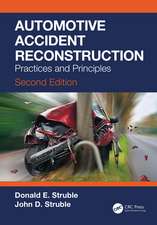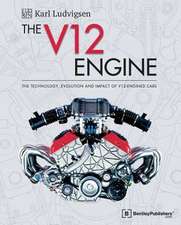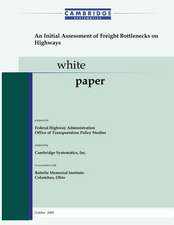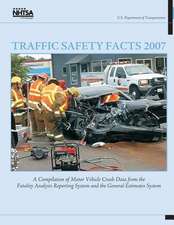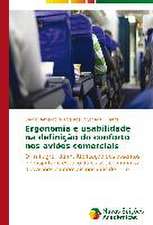Paving Our Ways: A History of the World’s Roads and Pavements
Autor Maxwell Lay, John Metcalf, Kieran Sharpen Limba Engleză Paperback – 23 noi 2020
It examines the earliest pavements in Egypt and Mesopotamia and then moves to North Africa, Crete, Greece and Italy, before a review of pavements used by the Romans in their magnificent road system. After its empire collapsed, Roman pavements fell into ruin. The slow recovery of pavements in Europe began in France and then in England.
The work of Trésaguet, Telford and McAdam is examined. Asphalt and concrete slowly improved as paving materials in the second part of the 19th century. Major advances occurred in the 20th century with the availability of powerful machinery, pneumatic tyres and bitumen. The advances needed to bring pavements to their current development are explored, as are the tools for financing, constructing, managing and maintaining pavements.
The book should appeal to those interested in road paving, and in the history of engineering and transport. It can also serve as a text for courses in engineering history.
| Toate formatele și edițiile | Preț | Express |
|---|---|---|
| Paperback (1) | 369.77 lei 6-8 săpt. | |
| CRC Press – 23 noi 2020 | 369.77 lei 6-8 săpt. | |
| Hardback (1) | 789.57 lei 6-8 săpt. | |
| CRC Press – 23 noi 2020 | 789.57 lei 6-8 săpt. |
Preț: 369.77 lei
Nou
Puncte Express: 555
Preț estimativ în valută:
70.75€ • 73.88$ • 58.43£
70.75€ • 73.88$ • 58.43£
Carte tipărită la comandă
Livrare economică 15-29 aprilie
Preluare comenzi: 021 569.72.76
Specificații
ISBN-13: 9780367520786
ISBN-10: 0367520788
Pagini: 314
Ilustrații: 16 Line drawings, black and white; 89 Halftones, black and white; 12 Tables, black and white; 105 Illustrations, black and white
Dimensiuni: 156 x 234 x 20 mm
Greutate: 0.45 kg
Ediția:1
Editura: CRC Press
Colecția CRC Press
ISBN-10: 0367520788
Pagini: 314
Ilustrații: 16 Line drawings, black and white; 89 Halftones, black and white; 12 Tables, black and white; 105 Illustrations, black and white
Dimensiuni: 156 x 234 x 20 mm
Greutate: 0.45 kg
Ediția:1
Editura: CRC Press
Colecția CRC Press
Public țintă
General, Professional, and Undergraduate CoreCuprins
Contents
Preface: What is a road pavement? ix
Authors xiii
1 How pavements are affected by traffic and weather 1
2 Early pavements in Egypt, Mesopotamia, Crete and Greece 7
3 Making pavements using local materials and simple equipment 13
4 The essential paving properties of soil, sand and stones 27
5 Paving ways through swamps and bogs 37
6 Roman pavements – a major advance in pavement quality and extent 43
7 Pavement management processes from medieval Europe 51
8 Trésaguet and Telford lead a pavement renaissance in France and England 59
9 McAdam invents a major new pavement using broken stones 67
10 Using masonry methods to produce pavements for heavy traffic 87
11 The essential paving properties of bitumen, asphalt and cement 99
12 Three unique pavement engineers – Metcalf, McAdam and Mountain 105
13 The first asphalt pavements, produced in 19th-century France and England 113
14 A new form of pavement using thin, sprayed bituminous surfacings 131
15 Asphalt paving produced to carry 20th-century truck traffic 137
16 The design of asphalt pavements – a predominantly American initiative 151
17 The 20th-century development of concrete pavements 165
18 Chemical and physical means of modifying local materials for paving 175
19 Devices and methods for measuring and evaluating pavement performance 181
20 Full-scale testing of pavements to validate designs using local materials 207
21 Possible future pavements, with an emphasis on recycling 229
22 How pavements could be funded and operated in future years 235
Timeline 239
Bibliography 253
End Notes 269
Index 291
Preface: What is a road pavement? ix
Authors xiii
1 How pavements are affected by traffic and weather 1
2 Early pavements in Egypt, Mesopotamia, Crete and Greece 7
3 Making pavements using local materials and simple equipment 13
4 The essential paving properties of soil, sand and stones 27
5 Paving ways through swamps and bogs 37
6 Roman pavements – a major advance in pavement quality and extent 43
7 Pavement management processes from medieval Europe 51
8 Trésaguet and Telford lead a pavement renaissance in France and England 59
9 McAdam invents a major new pavement using broken stones 67
10 Using masonry methods to produce pavements for heavy traffic 87
11 The essential paving properties of bitumen, asphalt and cement 99
12 Three unique pavement engineers – Metcalf, McAdam and Mountain 105
13 The first asphalt pavements, produced in 19th-century France and England 113
14 A new form of pavement using thin, sprayed bituminous surfacings 131
15 Asphalt paving produced to carry 20th-century truck traffic 137
16 The design of asphalt pavements – a predominantly American initiative 151
17 The 20th-century development of concrete pavements 165
18 Chemical and physical means of modifying local materials for paving 175
19 Devices and methods for measuring and evaluating pavement performance 181
20 Full-scale testing of pavements to validate designs using local materials 207
21 Possible future pavements, with an emphasis on recycling 229
22 How pavements could be funded and operated in future years 235
Timeline 239
Bibliography 253
End Notes 269
Index 291
Notă biografică
Dr Maxwell Lay is an engineering consultant known for his international
contributions to road engineering and his acclaimed international road
histories. He is a member of the Order of Australia, former Executive
Director of the Australian Road Research Board, and past President of
the Royal Automobile Club of Victoria and the Australian Automobile
Association. He has been awarded the Moisseif Medal of the American
Society of Civil Engineers, the Peter Nicol Russell, Warren and Transport
Medals of the Institution of Engineers Australia, and the Gold Medal
of Roads Australia. He is the author of Handbook of Road Technology
(CRC Press, 2019).
Dr John Metcalf has worked in pavement materials and engineering at
the British Road Research Laboratory, Queen’s University in Canada,
and the Queensland Main Roads Department. He was Deputy Director
of the Australian Road Research Board and later was appointed Chaired
Professor of Civil Engineering at Louisiana State University. He was a
Fellow of the (UK) Institution of Civil Engineers and the Geological Society
of London and a member of the American Society of Civil Engineers. He is
an Honorary Fellow of the Institution of Engineers Australia.
Kieran Sharp worked for the Australian Road Research Board (ARRB) as a
researcher in the fields of pavements, roads, and transport, and as technical
editor, for over 40 years. He was the first member of ARRB to receive an
Austroads Achievement Award. He is the Chair of the Technical Committee
of the Road Engineering Association of Asia and Australia, a member of the
Governing Council, and an Honorary Member. He was awarded the Roads
Australia Award for Technical Excellence in 2013.
contributions to road engineering and his acclaimed international road
histories. He is a member of the Order of Australia, former Executive
Director of the Australian Road Research Board, and past President of
the Royal Automobile Club of Victoria and the Australian Automobile
Association. He has been awarded the Moisseif Medal of the American
Society of Civil Engineers, the Peter Nicol Russell, Warren and Transport
Medals of the Institution of Engineers Australia, and the Gold Medal
of Roads Australia. He is the author of Handbook of Road Technology
(CRC Press, 2019).
Dr John Metcalf has worked in pavement materials and engineering at
the British Road Research Laboratory, Queen’s University in Canada,
and the Queensland Main Roads Department. He was Deputy Director
of the Australian Road Research Board and later was appointed Chaired
Professor of Civil Engineering at Louisiana State University. He was a
Fellow of the (UK) Institution of Civil Engineers and the Geological Society
of London and a member of the American Society of Civil Engineers. He is
an Honorary Fellow of the Institution of Engineers Australia.
Kieran Sharp worked for the Australian Road Research Board (ARRB) as a
researcher in the fields of pavements, roads, and transport, and as technical
editor, for over 40 years. He was the first member of ARRB to receive an
Austroads Achievement Award. He is the Chair of the Technical Committee
of the Road Engineering Association of Asia and Australia, a member of the
Governing Council, and an Honorary Member. He was awarded the Roads
Australia Award for Technical Excellence in 2013.
Recenzii
"I found much of interest from a heritage perspective in the changing technology across the world from China and Mesopotamia, Europe, Britain, Australia and North America, stretching from biblical times to the present
day. . . . The book should provide a comprehensive reference for civil engineering students and practising engineers,
and will be interesting from a history and heritage perspective for more general readers."
-- Keith Baker, Engineering Heritage Australia Magazine
"This is an excellent and very well documented history of road pavements. It provides a bonanza of information to any reader interested in the early roads, built millennia ago, as well as those constructed during the Industrial Revolution. It tells the story of the struggle to find a perfect an engineering solution to a complex problem: how to build durable and economical roads. The book is a joy to read. It presents in detail engineering principles, research trials and innovations, along with portraits of several major contributors to road pavement design and construction. Everyone interested in the history of road transport should buy this book; it is the best on the topic."
-- Stefan A. Romanoschi, Professor, University of Texas at Arlington
day. . . . The book should provide a comprehensive reference for civil engineering students and practising engineers,
and will be interesting from a history and heritage perspective for more general readers."
-- Keith Baker, Engineering Heritage Australia Magazine
"This is an excellent and very well documented history of road pavements. It provides a bonanza of information to any reader interested in the early roads, built millennia ago, as well as those constructed during the Industrial Revolution. It tells the story of the struggle to find a perfect an engineering solution to a complex problem: how to build durable and economical roads. The book is a joy to read. It presents in detail engineering principles, research trials and innovations, along with portraits of several major contributors to road pavement design and construction. Everyone interested in the history of road transport should buy this book; it is the best on the topic."
-- Stefan A. Romanoschi, Professor, University of Texas at Arlington
Descriere
Paving Our Ways is the only comprehensive history of the world’s pavements, from the earliest human settlements to the present day. It traces the human and social aspects of pavement development and use for general readers, with detailed technical background for students of transport engineering orengineering history and sociology.





